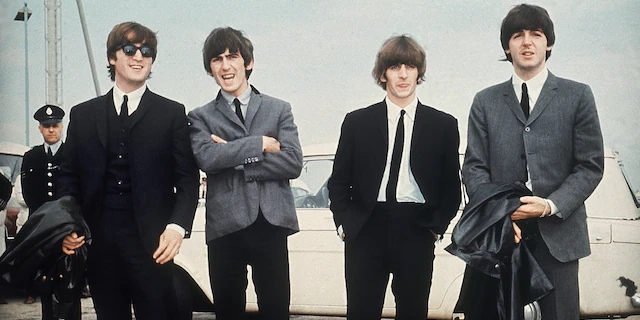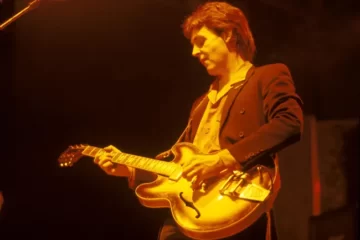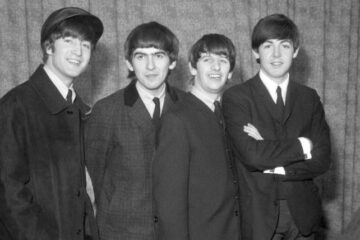In September 1963, following the first ripples of Beatlemania in Europe, The Beatles took a brief hiatus. John Lennon took his first wife, Cynthia, to Paris, and Paul McCartney joined Ringo Starr for a short trip to Greece. Meanwhile, George Harrison became the first Beatle to enter the US as he flew to visit his elder sister, Louise, in Illinois. During the holiday, Harrison frequented local record shops void of British rock and walked streets where no heads would turn.
During the trip, Louise introduced her brother to 17-year-old DJ Marcia Schafer, who worked at the West Frankfort radio station, WFRX-AM. She requested that Schafer play Harrison’s own copy of The Beatles’ first UK number-one hit single, ‘She Loves You’. Although this first airing reached a modest scattering of local ears, it was the first domino to tumble across the Atlantic.
After Harrison returned to the UK, Louise continued to visit Schafer, urging him to play The Beatles’ new singles. “Louise came to the station several times over the summer asking us to play the Beatles’ music, which up to that time had only been available in England,” Schafer told the Illinois Times in 2013.
On October 13th, 1963, The Beatles recorded ‘I Want to Hold Your Hand’ as their first four-track single. The track was subsequently issued in the UK on November 29th, with ‘This Boy’ as its B-side and on December 26th in the US, with ‘I Saw Her Standing There’ on its B-side.
Although the Fab Four had already released a handful of singles in the States, including September’s ‘She Loves You’, they had fallen short of the virulence to which manager Brian Epstein aspired. Understanding the importance of the American market, Epstein encouraged Lennon and McCartney to write a pop song tailored to US tastes.
At the time, McCartney was lodging at the London residence belonging to the parents of his then-girlfriend, Jane Asher. Here, he and Lennon wrote ‘I Want to Hold Your Hand’ in the basement, a small music room where Margaret Asher taught oboe lessons.
“We wrote a lot of stuff together, one on one, eyeball to eyeball,” Lennon reflected in a 1980 interview with Playboy. “Like in ‘I Want to Hold Your Hand,’ I remember when we got the chord that made the song. We were in Jane Asher’s house, downstairs in the cellar, playing on the piano at the same time. And we had, ‘Oh you-u-u/ got that something …’ And Paul hits this chord, and I turn to him and say, ‘That’s it!’ I said, ‘Do that again!’ In those days, we really used to absolutely write like that—both playing into each other’s noses.”
Although the single appeared just as compatible with the American climate as its predecessor, ‘She Loves You’, which struck number one in the UK, ‘I Want to Hold Your Hand’ became the first US number-one single for The Beatles on January 18th, 1964. This crucial milestone marked the true beginning of Beatlemania across the pond.
In 1964, The Beatles set a record of seven US number-one hits in one year, with ‘She Loves You’, ‘Can’t Buy Me Love’, ‘Love Me Do’, ‘A Hard Day’s Night’, ‘I Feel Fine’ and ‘Eight Days a Week’ all following suit. To this day, the record remains unbroken.
In February 1964, Harrison returned to the US with three famous friends in tow. The Fab Four duly consolidated their position at the British Invasion vanguard with a monumental TV performance on The Ed Sullivan Show. After rattling through their early hits, The Beatles closed the set with ‘I Want to Hold Your Hand’ to rapturous applause.
Over the decades since, several high-profile entertainers, including Billy Joel, Bruce Springsteen, Tom Petty and Gene Simmons, have cited this TV appearance as a crucial eureka moment. Meanwhile, Bob Dylan, who enjoyed a concurrent rise to prominence, would soon be inspired to incorporate contemporary rock elements into his foundational folk aesthetic.
Dylan’s rock segue was inspired in no small part by The Beatles’ success. In 2015, NME asked Dylan to name his favourite song by The Beatles. Picking out ‘I Want to Hold Your Hand’, the Nobel Prize winner commented: “They were doing things nobody was doing. Their chords were outrageous, just outrageous, and their harmonies made it all valid… I knew they were pointing the direction of where music had to go.”




